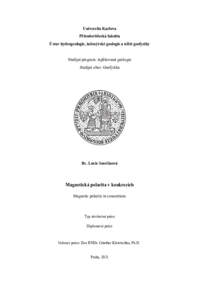Magnetická polarita v konkrecích
Magnetic polarity in concretions
diplomová práce (OBHÁJENO)

Zobrazit/
Trvalý odkaz
http://hdl.handle.net/20.500.11956/151011Identifikátory
SIS: 220519
Kolekce
- Kvalifikační práce [21483]
Autor
Vedoucí práce
Oponent práce
Adamovič, Jiří
Fakulta / součást
Přírodovědecká fakulta
Obor
Aplikovaná geologie
Katedra / ústav / klinika
Ústav hydrogeologie, inženýrské geologie a užité geofyziky
Datum obhajoby
13. 9. 2021
Nakladatel
Univerzita Karlova, Přírodovědecká fakultaJazyk
Čeština
Známka
Dobře
Klíčová slova (česky)
konkrece, magnetické pole, inverzeKlíčová slova (anglicky)
concretion, magnetic field, inversionTerestrické oxidy železa, kterými jsou např. hematit, goethit a magnetit, vytváří specificky stmelené konkrece v pískovcích pomocí vodného diagenetického roztoku. Časová osa, na které se konkrece vytvářejí, by mohla podle nových výsledků být mnohem rozsáhlejší než dosavadní odhady. Podkladem pro toto tvrzení je magnetický záznam konkrecí jurských pískovců Navajo v Utahu. Záznam obsahuje fluktuace remanentní magnetizace, které by mohly dokládat inverze magnetického pole Země. Toto pozorování naznačuje, že časová osa akumulace železitých konkrecí je srovnatelná s časovou osou akumulace oceánských železomanganových nodulí, které obsahují komplexní magnetický záznam. Výskyt extrémně pomalých změn ukládání železa v pískovcích také pomáhá více porozumět původu konkrecí. Pozemské konkrece navíc poskytují analogii pro "blueberries" nalezené Mars rover Opportunity na Marsu. Tyto konkrece nejspíše prošly podobnými procesy formování a mohly zaznamenat inverze raného magnetického dynama na Marsu.
Terrestrial iron oxides, such as hematite, goethite and magnetite, form specifically cemented concretions in sandstones using an aqueous diagenetic solution. According to the new results, the timeline on which concretions are formed could be much larger than current estimates. The basis for this claim is a magnetic record of the Jurassic Navajo Sandstone in Utah. The record contains fluctuations of remanent magnetization, which could prove the inversion of the Earth's magnetic field. This observation suggests that the time axis of the accumulation of iron concretions is comparable to the time axis of the accumulation of marine iron-manganese nodules, which contain a complex magnetic record. The occurrence of extremely slow changes in iron deposition in sandstones also helps to better understand the origin of concretions. In addition, terrestrial concretions provide an analogy for the "blueberries" found by the Mars rover Opportunity on Mars. These concretions probably underwent similar formation processes and could record inversions of the early magnetic dynamo on Mars.
